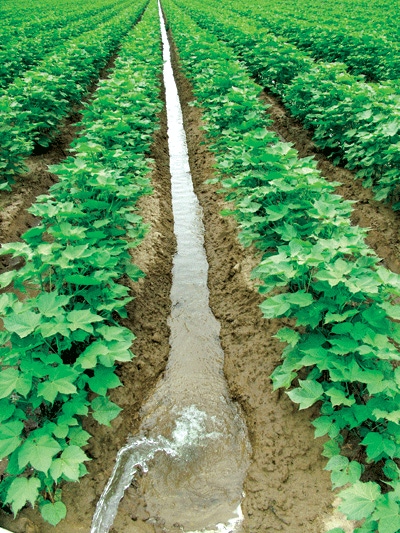
Mississippi water permit regs aim for sustainability
"We can’t keep doing what we’ve been doing and have a sustainable water supply for the generations to come,” Dean Pennington, executive director of the Yazoo Mississippi Delta Joint Water Management District told producers at the annual Delta Ag Expo at Cleveland, Miss. "By setting goals for a reasonable level of conservation that most landowners can meet, we can insure that every farm will have the water it needs for crop production.”

No place in the Mississippi Delta has ever had an irrigation well go dry, says Dean Pennington — “but with continuing overuse we’re seeing lower groundwater levels in the alluvial aquifer almost every year. We can’t keep doing what we’ve been doing and have a sustainable water supply for the generations to come.”By setting goals for a reasonable level of conservation that most landowners can meet, the executive director of the Yazoo Mississippi Delta Joint Water Management District told producers at the annual Delta Ag Expo at Cleveland, Miss., “We can insure that every farm will have the water it needs for crop production.”
To help accomplish this, “modest but significant changes” in permit regulations for irrigation water wells took effect Jan. 1.
Groundwater has been “a really good tool” for agriculture in the Delta since the 1970s, Pennington says, “but there is a modest level of urgency to make some practical changes in water usage in order to protect this resource and insure that a dry well never happens.”When annual measurements are made of water volume changes in the aquifer, “some years there are net gains, but we’ve had a lot more negative years, when water pumped out has been greater than that from recharge.”
Compared with the West and the Southwest regions of the nation, the Mississippi Delta has a lot of water, Pennington notes. “Our challenge is to use it as efficiently and effectively as possible. If we don’t, we’re headed for a time when we might not have the water we need.”
Regulations changed Jan. 1, 2011
Under regulation changes that began Jan. 1, permits for irrigation and aquaculture wells in the Mississippi River Alluvial Aquifer will be issued for 5 years, not 10 as previously. And the following conditions must be met to receive the full 5-year term:
•By the end of the third year of the permit, a minimum level of conservation practices must be in place, or
•A meter must be installed and an annual report of water use must be sent to the Mississippi Department of Environmental Quality.
These requirements apply to all irrigation and aquaculture groundwater permits.
Most permitting activity in the Delta is renewal of existing permits, Pennington notes, and renewals with no increase in permitted water volume do not require that a public notice be published in a local newspaper. However, all new and renewal applications with an increase in permitted water volume must be published in a local newspaper.
Qualifying conservation practices
There are many conservation practices that qualify users for
a full term permit, he says, such as installation of a sprinkler irrigation system or precision landforming with precision pads and pipes.
For row crops and rice, one of the following conditionss will qualify:
•All water from the well is applied through a sprinkler.
•Most of the irrigation runoff (tailwater) is captured by the applicant and reused. This option requires an active surface water permit. The captured runoff may be used on another location managed by the applicant. This option requires an unmetered report of the surface water permit associated with the groundwater runoff reuse.
•Surface water can be applied to at least 75 percent of the groundwater irrigated area. This option requires an unmetered report of the surface water permit associated with the groundwater runoff reuse.
If precision landforming is the option chosen for meeting the permit��’s conservation requirements, one of the following conditions must also be met:
•Permanent perimeter pipes and pads.
•Land formed to zero grade.
•PHAUCET or similar approved irrigation design computer program is used to design optimum polypipe hole sizes.
•Timer to automatically or remotely shut off the well.
•Side inlet water distribution is used if the acreage is in rice.
For aquaculture, any two of the following will qualify:
•The outlet pipe elevation is set equal to or higher than the typical pond levee height from May 1 through Oct. 31.
•There is a timer or device on the well to automatically or remotely shut it off.
•Pond levels are maintained to have several inches of unfilled pond storage that is managed by a visual water level-indicating device in the pond.
For wildlife habitat (migratory waterfowl):
•When available, surface water can be pumped or diverted onto the permitted area. A surface water permit is required for this option.
•The operator implements a program to capture rainfall on the site by closing a water control structure (like a slotted board riser) in the late summer or early fall.
Financial assistance for implementing conservation practices or purchasing and installing a flow meter may be available; information is available at local county NRCS offices.
Use of surface water, where available, as a primary water supply, with groundwater as a backup resource, has potential for significant reductions in groundwater use, Pennington says.
“Analyses show that if we can reduce groundwater usage by 10 percent to 20 percent, we can balance our water budget. Through practices such as tailwater recovery systems, land forming, and on-farm water storage structures, this is an attainable target and can provide a sustainable supply.”
About the Author(s)
You May Also Like



